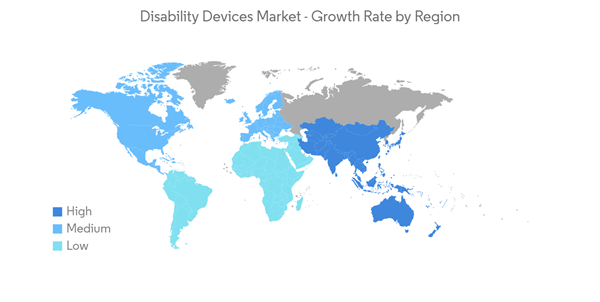The Global Disability Devices Market size is estimated at USD 21.24 billion in 2024, and is expected to reach USD 27.88 billion by 2029, growing at a CAGR of 5.60% during the forecast period (2024-2029).
The COVID-19 pandemic has significantly impacted the disability devices market. As per an April 2020 published article titled "Covid-19 And The Rights Of Persons With Disabilities: Guidance" by the United Nations, during the COVID-19 crisis, people with disabilities who are dependent on support for their daily living may find themselves isolated and unable to survive during lockdown measures, while those living in institutions are particularly vulnerable, as evidenced by the overwhelming numbers of deaths in residential care homes and psychiatric facilities. Thus, several measures were recommended during the pandemic to enhance services for the disabled. For instance, as per a World Health Organization (WHO) 2020 article titled, "Disability considerations during the COVID-19 outbreak", actions need to be taken to ensure that people with disabilities can always access healthcare services and public health information they require, including during the COVID-19 outbreak. This indicates that the demand for disability devices is likely to increase during the pandemic phase, thus, having a positive impact on the market growth.
Furthermore, the growth of the market can be attributed to factors such as the growing burden of disability and the rising number of initiatives about disability.
The growing burden of disability is driving the demand for several types of disability devices. For instance, as per a November 2021 update by the WHO, more than 1 billion people are estimated to experience disability. As per the same source, this corresponds to about 15% of the world's population, with up to 190 million (3.8%) people aged 15 years and older having significant difficulties in functioning, often requiring health care services. As per the same source, to improve access to and coverage of health services for people with disabilities, WHO guides and supports the Member States to increase awareness of disability issues and promotes the inclusion of disability as a component in national and sub-national health programs. The source also reports that WHO facilitates the collection and dissemination of disability-related data and information and develops normative tools, including guidelines to strengthen disability inclusion within health care services. It also states that the number of people with disabilities is dramatically increasing. This is due to demographic trends and increases in chronic health conditions, among other causes. Thus, the demand for disability devices among the patient population is expected to increase over the coming period.
However, the high cost of devices is a major factor restraining the growth of the disability device market.
The factors boosting the growth of this segment in the market are the increasing number of product launches as well as the rising number of initiatives along with the growing burden of disability worldwide. For instance, as per an October 2020 update by the Australian Institute of Health and Welfare (AIHW), around 1 in 6 (18%) people in Australia, or about 4.4 million people, have a disability.
In addition, in June 2021, the International Air Transport Association (IATA) launched global mobility aids action group to examine and improve the transport journey of mobility aids, including wheelchairs, to improve the handling of such devices for travelers with disabilities. Furthermore, research and development are contributing to the segment's growth. For instance, in August 2021, the Indian Institute of Technology (IIT), Madras, India, developed India's first indigenous motorized wheelchair vehicle that can be used not only on roads but even on uneven terrain. Moreover, several market players are also engaged in the implementation of strategic initiatives, thereby contributing to the segment's growth. For instance, in August 2021, Invacare Corporation announced the launch of the Invacare AVIVA STORM RXT power wheelchair, establishing a new standard for rear-wheel-drive power mobility.
Thus, due to the above-mentioned developments, the segment is expected to witness growth over the forecast period.
Furthermore, according to a White House update from February 2022, the Administration recognizes that the COVID-19 pandemic has had a significant impact on disabled people and has resulted in new members of the disability community. The Administration has collaborated and consulted with the disability community and taken several key actions to address the unique needs of individuals with disabilities.
Moreover, in August 2021, Bose launched the new SoundControl Hearing Aids, the first Food and Drug Administration (FDA)-cleared, direct-to-consumer hearing aid developed for adults with perceived mild-to-moderate hearing loss. Such launches are expected to further contribute to the market's growth.
Thus, due to the above-mentioned developments, the market is expected to witness significant growth.
This product will be delivered within 2 business days.
The COVID-19 pandemic has significantly impacted the disability devices market. As per an April 2020 published article titled "Covid-19 And The Rights Of Persons With Disabilities: Guidance" by the United Nations, during the COVID-19 crisis, people with disabilities who are dependent on support for their daily living may find themselves isolated and unable to survive during lockdown measures, while those living in institutions are particularly vulnerable, as evidenced by the overwhelming numbers of deaths in residential care homes and psychiatric facilities. Thus, several measures were recommended during the pandemic to enhance services for the disabled. For instance, as per a World Health Organization (WHO) 2020 article titled, "Disability considerations during the COVID-19 outbreak", actions need to be taken to ensure that people with disabilities can always access healthcare services and public health information they require, including during the COVID-19 outbreak. This indicates that the demand for disability devices is likely to increase during the pandemic phase, thus, having a positive impact on the market growth.
Furthermore, the growth of the market can be attributed to factors such as the growing burden of disability and the rising number of initiatives about disability.
The growing burden of disability is driving the demand for several types of disability devices. For instance, as per a November 2021 update by the WHO, more than 1 billion people are estimated to experience disability. As per the same source, this corresponds to about 15% of the world's population, with up to 190 million (3.8%) people aged 15 years and older having significant difficulties in functioning, often requiring health care services. As per the same source, to improve access to and coverage of health services for people with disabilities, WHO guides and supports the Member States to increase awareness of disability issues and promotes the inclusion of disability as a component in national and sub-national health programs. The source also reports that WHO facilitates the collection and dissemination of disability-related data and information and develops normative tools, including guidelines to strengthen disability inclusion within health care services. It also states that the number of people with disabilities is dramatically increasing. This is due to demographic trends and increases in chronic health conditions, among other causes. Thus, the demand for disability devices among the patient population is expected to increase over the coming period.
However, the high cost of devices is a major factor restraining the growth of the disability device market.
Disability Devices Market Trends
Mobility Aids Segment is Expected to Hold a Major Market Share in the Disability Devices Market
By device type, the mobility aids segment is expected to hold a major share of the market. A mobility aid is a device designed to assist in walking or otherwise improve the mobility of people with a mobility impairment. There are a variety of walking aids available to assist people with impaired walking ability, as well as wheelchairs or mobility scooters for more severe disabilities or longer journeys that would otherwise be undertaken on foot. The types of mobility devices available in the market include canes, crutches, wheelchairs, and walkers, among others types of mobility devices.The factors boosting the growth of this segment in the market are the increasing number of product launches as well as the rising number of initiatives along with the growing burden of disability worldwide. For instance, as per an October 2020 update by the Australian Institute of Health and Welfare (AIHW), around 1 in 6 (18%) people in Australia, or about 4.4 million people, have a disability.
In addition, in June 2021, the International Air Transport Association (IATA) launched global mobility aids action group to examine and improve the transport journey of mobility aids, including wheelchairs, to improve the handling of such devices for travelers with disabilities. Furthermore, research and development are contributing to the segment's growth. For instance, in August 2021, the Indian Institute of Technology (IIT), Madras, India, developed India's first indigenous motorized wheelchair vehicle that can be used not only on roads but even on uneven terrain. Moreover, several market players are also engaged in the implementation of strategic initiatives, thereby contributing to the segment's growth. For instance, in August 2021, Invacare Corporation announced the launch of the Invacare AVIVA STORM RXT power wheelchair, establishing a new standard for rear-wheel-drive power mobility.
Thus, due to the above-mentioned developments, the segment is expected to witness growth over the forecast period.
North America is Expected to Hold a Significant Share in the Market and Expected to do Same in the Forecast Period
Within North America, the United States is expected to hold a significant market share. This can be attributed to factors such as well-established healthcare infrastructure, the growing burden of the disabled population, as well as strategic initiatives undertaken by the market players. For instance, as per an August 2021 article by the Centers for Disease Control and Prevention (CDC), more than 1 in 4 United States adults between 18 to 64 years of age has a disability. These are adults with serious difficulty walking or climbing stairs, hearing; seeing; concentrating, remembering, or making decisions. Thus, this indicates a significant demand for disability devices in the country.Furthermore, according to a White House update from February 2022, the Administration recognizes that the COVID-19 pandemic has had a significant impact on disabled people and has resulted in new members of the disability community. The Administration has collaborated and consulted with the disability community and taken several key actions to address the unique needs of individuals with disabilities.
Moreover, in August 2021, Bose launched the new SoundControl Hearing Aids, the first Food and Drug Administration (FDA)-cleared, direct-to-consumer hearing aid developed for adults with perceived mild-to-moderate hearing loss. Such launches are expected to further contribute to the market's growth.
Thus, due to the above-mentioned developments, the market is expected to witness significant growth.
Disability Devices Industry Overview
The disability devices market is competitive with the presence of several global and international market players. The key players are adopting different growth strategies to enhance their market presence, such as partnerships, agreements, collaborations, new product launches, geographical expansions, mergers, and acquisitions. Some of the key players in the market are Ottobock, Sunrise Medical, Invacare Corporation, GF Health Products, and Cochlear Limited.Additional Benefits:
- The market estimate (ME) sheet in Excel format
- 3 months of analyst support
This product will be delivered within 2 business days.
Table of Contents
1 INTRODUCTION
4 MARKET DYNAMICS
5 MARKET SEGMENTATION (Market Size by Value- USD million)
6 COMPETITIVE LANDSCAPE
Companies Mentioned (Partial List)
A selection of companies mentioned in this report includes, but is not limited to:
- Cochlear Limited
- MED-EL Medical Electronics.
- GF Health Products
- Ottobock
- Invacare Corporation
- Sunrise Medical
- Ottobock
- Demant A/S
- Pride Mobility Products
- Merits Health Products Co., Ltd.
- Meyra Group
- Sivantos, Inc. (Signia)
- ReSound
Methodology

LOADING...










